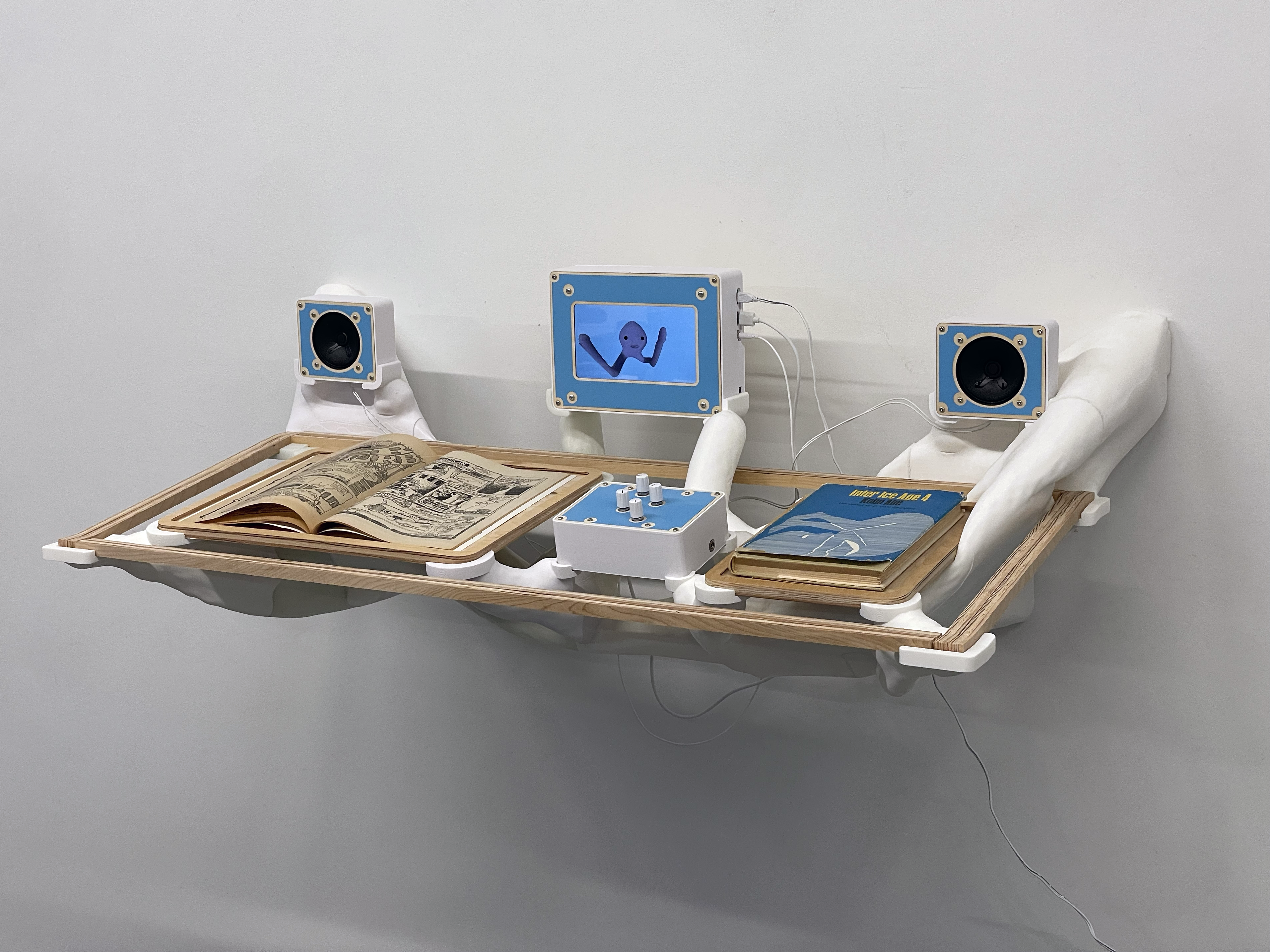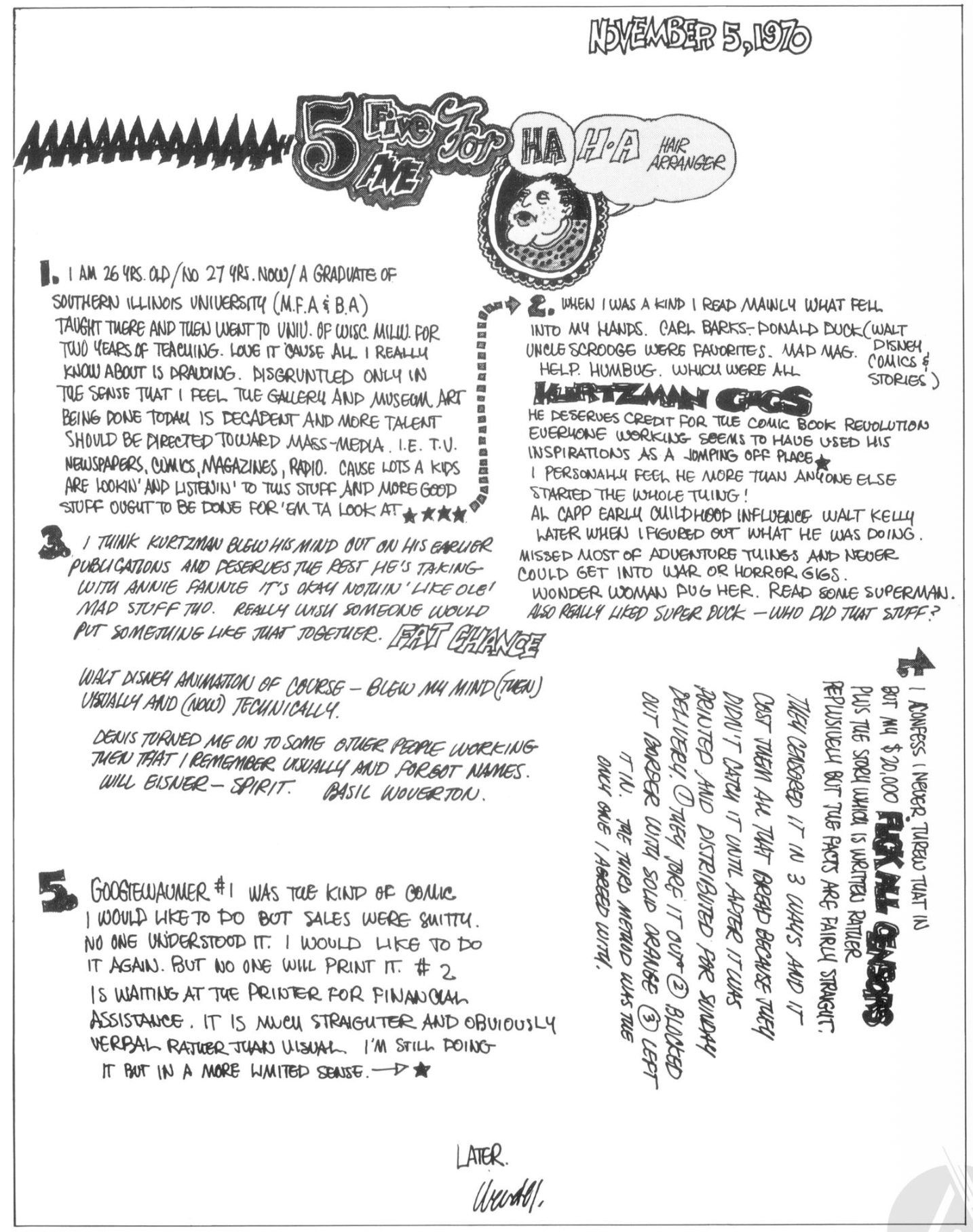PLA, wood, vinyl, LCD screen, speakers, Arduino, Raspberry Pi, hardware
contains copies of Inter Ice Age 4 (1969) by Kobo Abé and Googiewaumer Comics (1969) by Wendell Allen Pugh
4’x2’x1’
a platform for upholding discrete pieces of media



Inter Ice Age 4 is a science fiction novel by Kobo Abé, an author often referred to as “the Kafka of Japan,” for his work’s existentialist themes and uncanny qualities. The book, originally serialized in the journal Sekai from 1958-59, was prescient in combining subject matter as wide ranging as AI, climate change and genetic engineering. The convoluted plot follows Professor Katsumi of the Institute for Computer Technique, who, as “the only person in Japan specialized in programming,” has been tasked by his country’s government to create a “forecasting machine” capable of predicting the future. Katsumi’s quest to gather data to feed his machine for testing, leads to him discovering a conspiracy involving scientists using genetic engineering to create a new species of amphibian humans. This species, with their webbed feet and gills, will allow a new version of humanity to survive in underwater societies after climate change causes the ice caps to melt and ocean levels to rise.




Inter Ice Age 4 cover and illustrations by Machi Abé, wife of Kobo Abé
Having grown up moving between different locations in Japan and China, Abé described himself as rootless and eventually came to reject all forms of nationalism and ceremony. In a 1986 interview he claimed for this reason to have refused to attend his daughter’s wedding, and that he likewise planned on not attending his mother’s funeral after her death. He was a leftist, and at one point a member of the Japanese Communist Party, but became politically disillusioned after a visit to Budapest just before the Hungarian uprising. For many years he was also best friends with Yukio Mishima before the rift between their politics became too large for the two of them to bear. In addition to publishing dozens of novels, short stories, plays and essays, as well as two poetry collections, Abé also created an internationally touring theatre company, writing and directing plays that he would perform live music for on his EMS and Moog synthesizers.
The only footage of Abé I can find online. (If you know of any others please send them to me)
Googiewaumer is an obscure underground comic book created by Wendell Allen Pugh and published by The Print Mint in 1969. Most of the comic consists of "The Adventures of Super Ghurb” following a blobby creature with ambiguous and plastic features, broken up by shorter pieces of hippie-commentary on American consumerism and conformity. Storylines are nonseniscal and imagery is heavy with nature and factories, as well as the resulting consumer goods produced from these resources: appliances, televisions, computers, cars and soft drinks. Pugh is a far less recognized and prolific figure than Abé. As a marginal member of the 60’s underground comics scene, Googiewaumer is his only published material outside of a few short strips featured in other publications. The only interview he ever gave appears to have been for Mark James Estren’s A History of Underground Comics where he commented on the influence of his education, earning an MFA at Southern Illinois University, stating "My stuff is all fucked up because I went to school for six years and got all involved in aesthetics and professionalism, which I've decided is all bullshit. Wish I'd never learned to draw.”








Googiewaumer Comics cover and select pages
Despite the unbeloved status the comic seems to have among enthusiasts, as well as its own creator, Googiewaumer stands out as one of the most avant-garde works to emerge from the 60’s underground scene, pushing the medium into territories rarely seen before or since. The shapes of the panels mimic the organic, fungal appendages of the “Super Ghurbs”, illustration styles and orientation of panels change on the same page, and speech bubbles are as likely to be filled with coherent sentences as they are to be with made-up words and icons. Googiewaumer is a testament to the freedom found by some within 60’s counterculture, that afforded artists the ability to create and distribute truly strange work, regardless of its commercial viability or lack-there-of. The comic is also a story of the limits of that freedom. In Pugh’s interview with Estren, he reveals the existenc of a second issue of Googiewaumer, never to be published due to lack of interest “Googiewaumer #1 was the kind of comic I would like to do but sales were pretty shitty. No one understood it. I would like to do it again. But no will will print it. #2 is wating at the printer for financial assistance. It is much straighter and obvioiusly verbal rather than visual. I’m still doing it but in a more limited sense.”

Pugh is number 8

Letter from Pugh to Estren
***
Sources
David Remnick, “Kobo Abe: A Figure Apart”, Washington Post, 1986
Henry Scott-Stokes, “Japan’s Kafka Goes On The Road”, New York Times, 1979
M. Steven Fox, “Googiewaumer Comics”, comixjoint.com
Mark James Estren, A History of Underground Comics, 1974
back